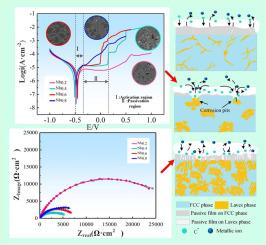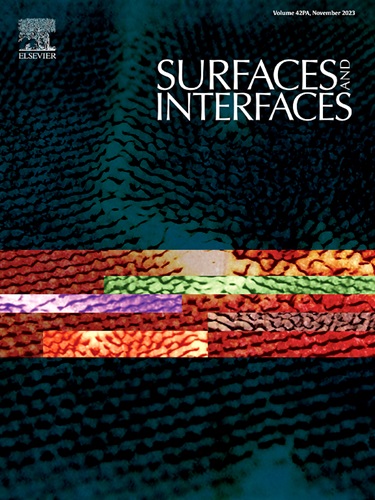Electrochemical corrosion behavior and passive film properties of Fe2Ni2CrV0.5Nbx (x=0.2, 0.4, 0.6, 0.8) eutectic high-entropy alloy coating prepared by laser cladding
IF 5.7
2区 材料科学
Q2 CHEMISTRY, PHYSICAL
引用次数: 0
Abstract
The phase composition, microstructure morphology, and corrosion behavior of Fe2Ni2CrV0.5Nbx (x = 0.2, 0.4, 0.6, 0.8) eutectic high-entropy alloy (EHEA) coatings produced via laser cladding were investigated. The research delved into discerning the phase structures and microstructural variations of the EHEA coatings concerning differing Nb compositions. The findings highlighted a direct correlation between Nb content and the volume fraction of the eutectic structure, specifically the FCC/Laves phases. Electrochemical evaluations, including diverse tests such as potentiodynamic polarization, electrochemical impedance spectroscopy, cyclic polarization, Mott-Schottky measurements, and X-ray photoelectron spectroscopy, revealed distinct corrosion behaviors among the EHEA variants. Notably, the Fe2Ni2CrV0.5Nb0.2 coating exhibited relatively superior corrosion resistance compared with Fe2Ni2CrV0.5Nbx (x = 0.4,0.6,0.8) coatings, attributed to its lower corrosion current density (Icorr) and the formation of a thicker passive film with prolonged passivation duration. Conversely, the Fe2Ni2CrV0.5Nb0.8 coating, characterized by increased eutectic structures and grain boundary density, yielded a thicker yet non-uniform passive film with higher vacancy defects. This comprehensive exploration into the corrosion behavior and passive film properties of these EHEA coatings provides a reference for designing materials that hold promising implications for future corrosion-resistant material development in industrial parts repair applications.

激光熔覆制备的 Fe2Ni2CrV0.5Nbx (x=0.2, 0.4, 0.6, 0.8) 共晶高熵合金涂层的电化学腐蚀行为和被动膜特性
研究了通过激光熔覆生产的 Fe2Ni2CrV0.5Nbx(x = 0.2、0.4、0.6、0.8)共晶高熵合金(EHEA)涂层的相组成、微观结构形态和腐蚀行为。研究深入探讨了不同铌成分的 EHEA 涂层的相结构和微观结构变化。研究结果表明,铌含量与共晶结构(特别是 FCC/Laves 相)的体积分数直接相关。电化学评估包括各种测试,如电位动力极化、电化学阻抗光谱、循环极化、Mott-Schottky 测量和 X 射线光电子能谱,这些评估揭示了不同 EHEA 变体之间截然不同的腐蚀行为。值得注意的是,与 Fe2Ni2CrV0.5Nbx(x = 0.4、0.6、0.8)涂层相比,Fe2Ni2CrV0.5Nb0.2 涂层表现出相对较强的耐腐蚀性,这归因于其较低的腐蚀电流密度(Icorr)和较厚的被动膜的形成以及较长的钝化持续时间。相反,Fe2Ni2CrV0.5Nb0.8 涂层的特点是共晶结构和晶界密度增加,形成的被动膜较厚但不均匀,空位缺陷较多。对这些 EHEA 涂层的腐蚀行为和被动膜特性的全面探索为设计材料提供了参考,对未来工业零部件维修应用中的耐腐蚀材料开发具有重要意义。
本文章由计算机程序翻译,如有差异,请以英文原文为准。
求助全文
约1分钟内获得全文
求助全文
来源期刊

Surfaces and Interfaces
Chemistry-General Chemistry
CiteScore
8.50
自引率
6.50%
发文量
753
审稿时长
35 days
期刊介绍:
The aim of the journal is to provide a respectful outlet for ''sound science'' papers in all research areas on surfaces and interfaces. We define sound science papers as papers that describe new and well-executed research, but that do not necessarily provide brand new insights or are merely a description of research results.
Surfaces and Interfaces publishes research papers in all fields of surface science which may not always find the right home on first submission to our Elsevier sister journals (Applied Surface, Surface and Coatings Technology, Thin Solid Films)
 求助内容:
求助内容: 应助结果提醒方式:
应助结果提醒方式:


